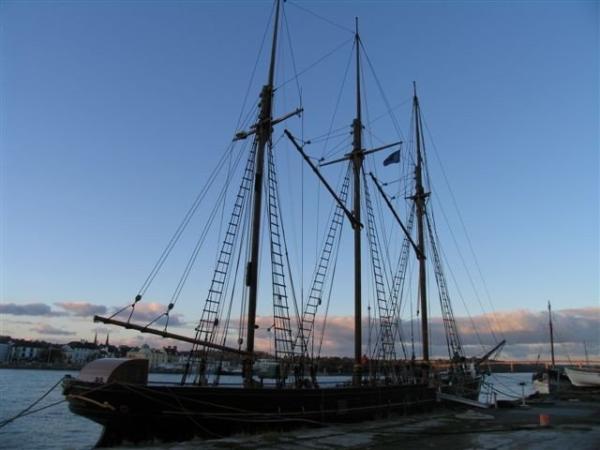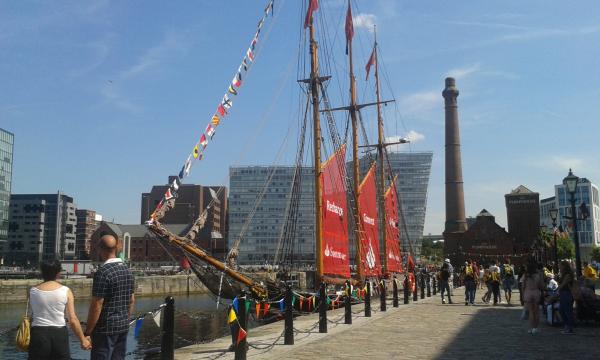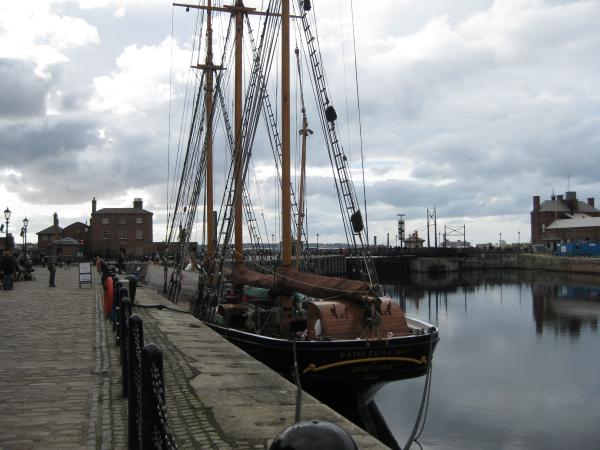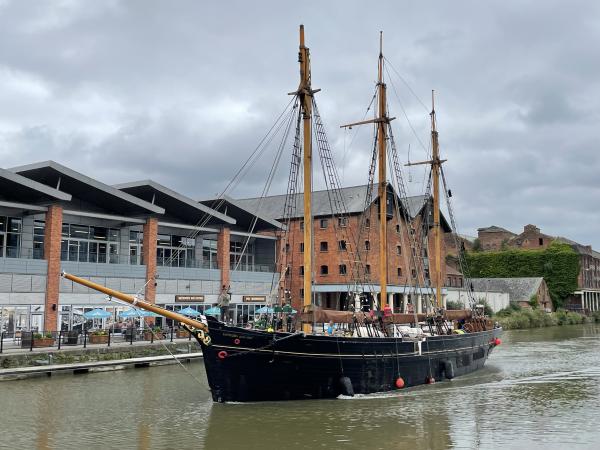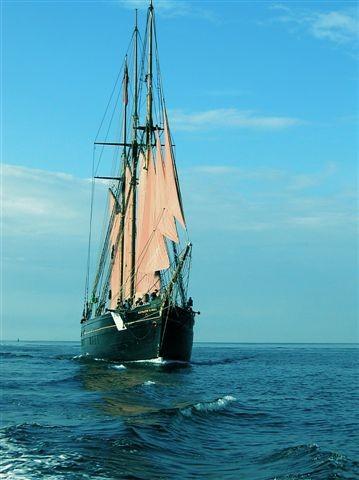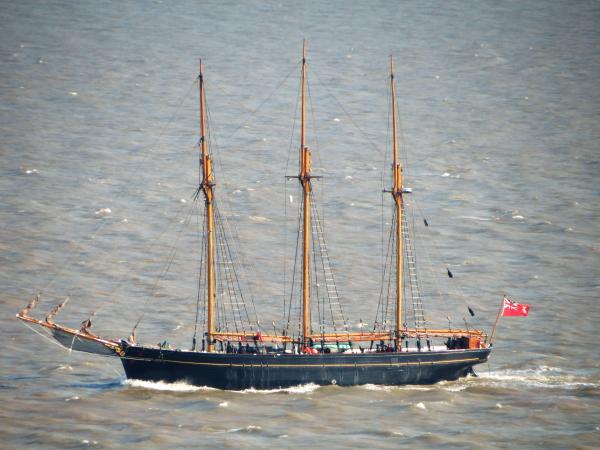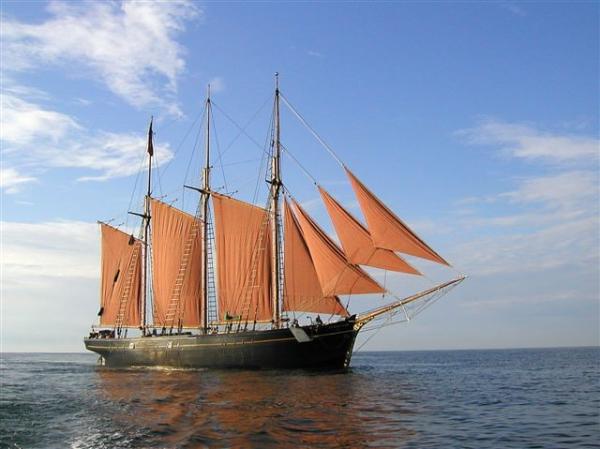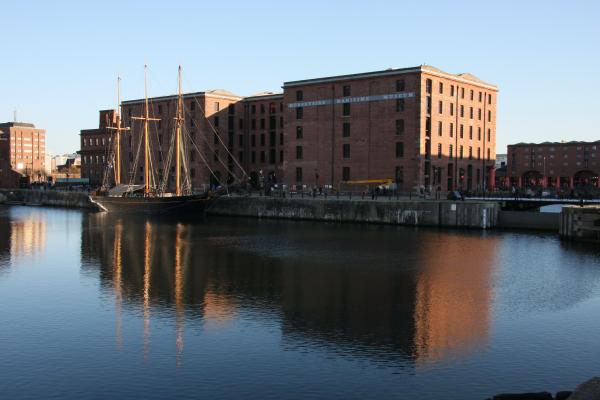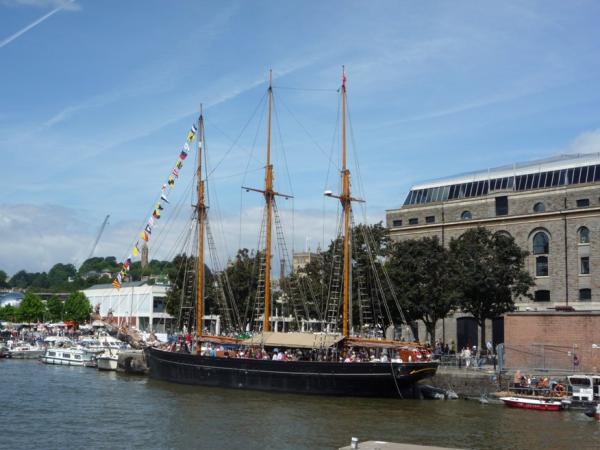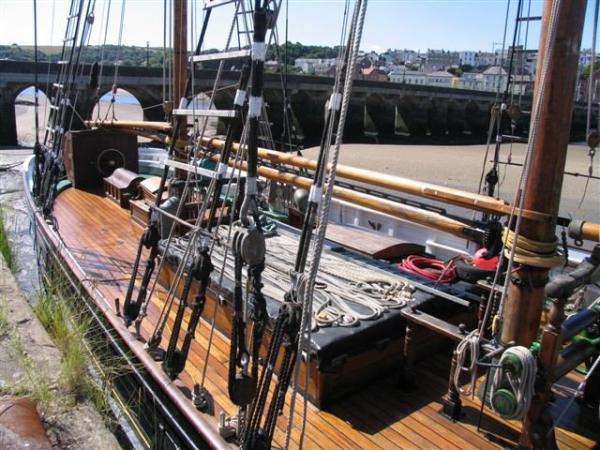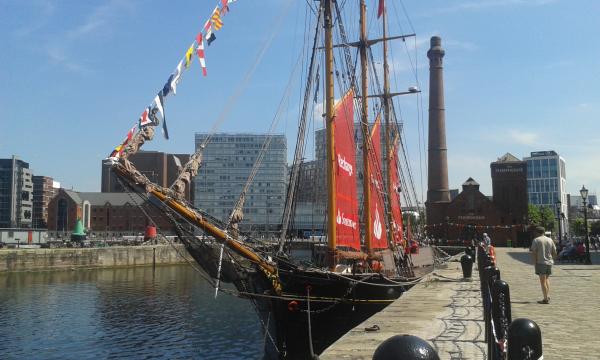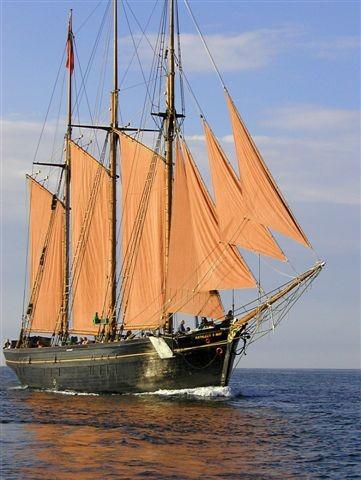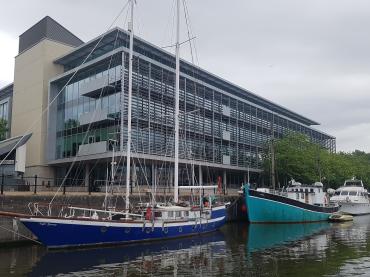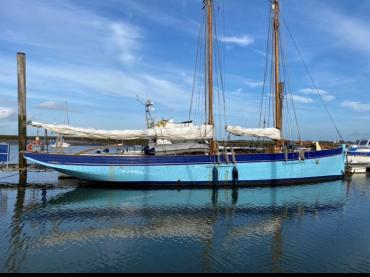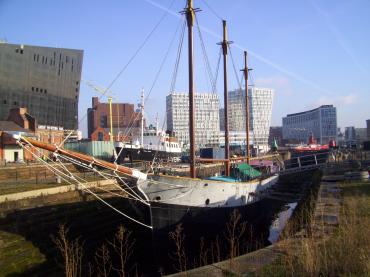

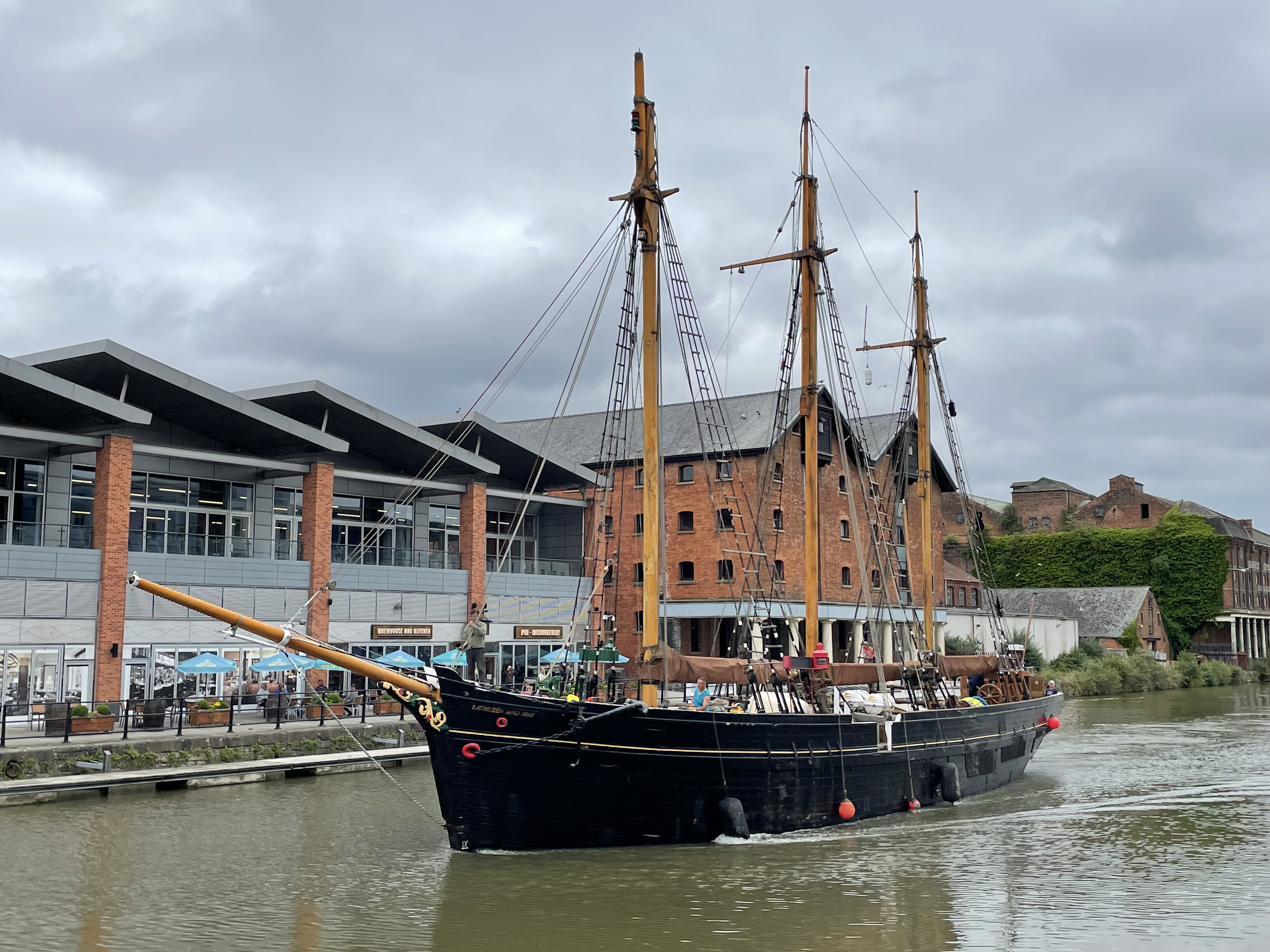
Previous names
- 1900 - 1908 Lizzie May
Details
Construction
Dimensions
History
KATHLEEN & MAY was built for leading shipowner Captain John Coppack and named after his daughters Lizzie and May. She was employed taking cargoes such as cement, coal, pitch and clay anywhere between Oban, Scotland and the Channel Islands. Her fo'c'sle could house four hands, while the Captain and mate occupied small cabins leading off the saloon, which also served as a mess room.
Her first commercial voyage was under Captain Tom Hughes from Connah's Quay to Rochester with 226 tons of firebricks. She then carried cement to Plymouth, pitch to Cardiff, coal to Falmouth and clay to Weston Point. In her first 8 years, she sailed nearly 40,000 miles, carrying various cargoes of over 24,000 tons.
In 1908, she was purchased by M J Fleming of Youghal in Southern Ireland, renamed KATHLEEN & MAY after his daughters, and placed in the coal trade between the Bristol Channel and Ireland, carrying oats or pit props on the return passages. Under Captain Joe Aherne of Youghal she imported coal from Lydney and from Garston, often carrying oats or pit props on the outward voyage.
Her first wartime voyage commenced on 25 January 1915. The vessel left Youghal with a crew of eight. These were the Master (J. Aherne, 40); the Mate (P. Aherne, 52); four able bodied seamen (G. Thurney, 54; Michael O’Keeffe, 30 and two others); a cook (Patrick Cadogan, 20); and an assistant cook, aged 16). The ports of call were Cardiff, Bristol, Youghal and Lydney.
KATHLEEN AND MAY was then laid up in Youghal until 29 June 1915. The Master, Joseph Aherne, reported that ‘Ships boats in constant use in every port; have also examined life-saving appliances and found same in good condition.’
The next voyage commenced on 11 July 1915. This time the crew was reduced to five. It consisted of the previous crew with the exception of two of the able bodied seamen and the assistant cook. The voyage involved sailing to Newport, Monmouthshire, after which KATHLEEN AND MAY returned to Youghal, arrived on August 14. She set off again across the Irish Sea, arriving at Bristol on August 23. She sailed further up the Severn, arriving at Lydney on August 25.
By September 14 she was back at Youghal in Ireland. She set sail again, arriving back at Newport on October 25. She arrived back at Youghal again on December 10, and by December 18 she had returned to Bristol. In his log for the period July to December 1915 the Master, Joseph Aherne, reports that: ‘Boat drill has been performed at each port and all life-saving appliances examined and all found satisfactory’.
On St George's Day 1931, she carried her last cargo under sail alone - 202 tons of coal from Cardiff. In that year, she was purchased by Captain Jewell, fitted with an 80HP auxiliary engine and her topmasts were shortened. Captain Jewell died in 1945 and KATHLEEN & MAY was left to his son Tommy who continued to operate her until 1961, after which she had a series of owners until she finally retired in 1967.
During 1968, KATHLEEN & MAY was discovered in bad repair by the Duke of Edinburgh who created the Maritime Trust in London to help preserve her. She was bought by them in 1970 with funds given by the Hong Kong shipowner Sir Yue-Kong Pao. After restoration work was carried out by the Trust in Appledore by Mashford’s Yard in Cremyll, KATHLEEN & MAY was opened to the public in Sutton Harbour, Plymouth from 1971 to 1978, when she was towed to St Katharine’s Dock and to St Mary Overie Dock, the latter which now houses the GOLDEN HIND. Following the disbursement of the Maritime Trust’s Historic Collection of vessels, KATHLEEN & MAY was subsequently sold to the Tall Ships Restoration Trust to save her from scrappage and salvage given her historic significance to the nation. T. Nielsen & Co had her towed from London to Gloucester where she was laid up, under canvas in Gloucester Docks. In 1998, she was purchased by the late Steve Clarke OBE. She was towed to Bideford by the Tug, DATCHET OF SEVERN SEAS, to the Port of Bideford with which formerly she had been associated, and where she was preserved to full working order at Brunswick Wharf.
She underwent a complete restoration to full sailing condition back to her original 1900 build, with the exception of some up to date conveniences like heads and a 400 hp engine. She has subsequently sailed across the Irish Sea and the Bristol Channel several times and has attended festivals in Dublin, Bristol, Derry and her old home port of Youghal. For example, in 2008, she was chartered by Companie de Transport Maritime a la Voile to carry 30,000 bottles of French wine to Dublin. She has crossed the Bay of Biscay to Bilbao where she was the paid guest of the famous Guggenheim museum for three weeks and, following a £2m refit, she set sail from Bideford to attend various maritime festivals during the summer of 2011. She took part in the Thames Diamond Jubilee Pageant on the 3rd of June 2012 as one of 250 vessels in the Avenue of Sail on the River Thames.
Watch an archive video featuring KATHLEEN & MAY making a delivery of milk nuts, believed to be her last ever working trip, here
By 2014, KATHLEEN & MAY had taken up a berth in Albert Dock, Liverpool as a guest of the Liverpool Maritime Museum. Following damage sustained to her bowsprit and part of her hull, KATHLEEN & MAY made passage using her engine to Gloucester Docks, arriving June 2021 for repair by the shipyard of T.Nielsen & Co. The repairs were completed by September 2022, with masts de-stepped in June 2022. A bespoke frame and canvas to protect her timbers from the elements was installed and erected by 2022 by Elite Yacht Covers. KATHLEEN & MAY has been laid up and tied alongside the quayside since and is under maintenance from a volunteer crew under the guidance of the T.Nielsen & Co. From time to time, she is open to members of the public.
Significance
1. What is the vessel’s ability to demonstrate history in her physical fabric?
Evidence for designs, functions, techniques, processes, styles, customs and habits or uses and associations in relation to events and people. How early, intact or rare these features are may impact on significance.
As the UK’s last wooden hulled three-masted topsail schooner, KATHLEEN & MAY typifies the great era of the British merchant schooner with a rig that was widely adopted from the 1870s to the First World War due to its efficient and economical form. Both rig and hull were crafted, then subsequently repaired and reconstructed, using traditional techniques developed over 400 years. At build, KATHLEEN & MAY incorporated the first known example of the Appledore roller reefing gear which has been fully restored on all three booms. In 1931, she was fitted with an engine, her topmasts reduced in height and square topsails removed. During conservation work undertaken in the late 1990s, approximately 85% of her planking and 60% of the frames were replaced and she was re-decked. Most of her internal timbers and fittings remain original, but the waterways and margin boards were renewed. The Balau decking was fastened to the beams with 7inch galvanised spike nails, caulked with oakum and payed with marine glue, as was the hull planking. The deck furniture and hatches were removed and renovated. A new oak samson post was fitted forward and the hatch coamings were also renewed. As the keel was hogged by approximately 16 inches, Appledore Shipbuilders fabricated a false steel channel keel which was fastened through the centre line framing of the ship by a stainless threaded steel bar to produce a straight line to the bottom of the keel. The steel standing rigging was overhauled prior to stepping the masts. In 2001, her rig was restored to its original specification, a sail is no longer carried on the crossed yard on the foremast which was used in the original square topsail configuration. As one of her authentic features, the Captain’s quarters were restored to their original position in the stern, comprising a saloon, and comfortable sleeping cabin, reflecting the high social status of the vessel owner in the quality of craftmanship. A prayer from her Irish ownership can still be seen in the saloon panelling. Working with Cammell Laird, the engine and generator were replaced in 2015 by maritime specialist James Troop with a Volvo Penta D13 450 bhp engine installed. In 2021, KATHLEEN & MAY underwent repairs to her bowsprit, hull and re-caulking work was undertaken. She was de-rigged and a bespoke frame and canvas was installed to protect her from the elements.
2. What are the vessel’s associational links for which there is no physical evidence?
Associations with people or places. Off-ship research.
KATHLEEN & MAY was built by the reputable wooden shipbuilders Ferguson and Baird at Connahs Quay on the River Dee, North Wales in 1900 and is now the last surviving Welsh-built merchant sailing vessel. She was commissioned by leading Chester ship-owner Captain John Coppack and originally named LIZZIE MAY after his daughters. Links have been re-established with Captain John Coppack’s great-great grandson and local history societies, underpinning the importance of her Welsh associations. KATHLEEN & MAY covered a wide geographical area during her working life in the home trade, sailing between Scotland, London, the Channel Islands and later between Cardiff, Ireland, Liverpool and the West Country. Achieving nearly 40,000 nautical miles in her first eight years of sail, she had a clear national significance to the coast of Britain. Under ownership of Martyn J. Fleming of Youghal in Ireland, she was re-named KATHLEEN & MAY after his two daughters and developed a strong local connection to that area with links that are still present as of 2025, as well as to the Bristol Channel where she plied the coal trade. In this role, she is illustrative of national efforts to maintain an essential trade in basic materials during the First World War. In 1969 the Duke of Edinburgh, the late Prince Philip, who had been instrumental in the rescue and restoration of CUTTY SARK, started the Maritime Trust as a means of preserving other significant British ships, with KATHLEEN & MAY an early object of attention as a national icon. She was purchased by the Trust in 1970 with funds from the Hong Kong ship-owner Sir Yue-Kong Pao and, after conservation, was opened to the public first in Sutton Harbour, Plymouth, then in London at St Katharine’s Dock and St Mary Overie Dock. Following disbursement of the Trust’s collection, she was later purchased by the late Steve Clarke OBE. She was towed to the Port of Bideford, with which she had formerly been associated, and preserved to full working order at Brunswick Wharf. From 2002 until 2017, she cruised the UK coast attending maritime festivals and visiting once more her considered home port of Youghal where she was the subject of a documentary film. She developed European links, being chartered for the first time by Companie de Transport Maritime a la Voile to carry 30,000 bottles of French wine to Dublin and also crossing the Bay of Biscay to Bilbao where she was the guest of the Guggenheim Museum for three weeks. Records survive of the cargoes carried in her working days as a coastal trading schooner from 1900 to 1960, together with a range of historic photographs and paintings, and logs from the First World War era. KATHLEEN & MAY was recorded on the National Register of Historic Vessels in 2001 and given the status of inclusion in the National Historic Fleet.
3. How does the vessel’s shape or form combine and contribute to her function?
Overall aesthetic impact of the vessel, her lines, material she was built from and her setting. Does she remain in her working environment?
KATHLEEN & MAY was substantially built to carry a cargo of 226 tons over a considerable distance around the UK coastline. Her planks were of three inch pitch pine, laid on doubled oak frames and fastened with tree nails and iron bolts. She has an elegant semi-elliptical stern and a sailing rig of a kind first developed in Britain in the late eighteenth and early nineteenth centuries through North American connections. Her form made her fit for purpose, as well as being economical and a handsome vessel. Carrying as small a crew as possible was crucial to commercial success for modest sailing cargo vessels: the roller reefing gear fitted to the fore-and-aft sails on KATHLEEN & MAY was an important innovation in keeping crew numbers and costs to the minimum consistent with operating the ship to the highest achievable levels of performance. Until 2018, KATHLEEN & MAY remained in operational condition, cruising the same waters she once traded before being laid up in Liverpool, then returning to Gloucester, an appropriate setting which highlights her significance as one of the few historic sailing merchant ships to have survived from this coastline. She is currently laid up alongside the quayside, maintained by volunteers with occasional public openings.
Source: NHS-UK team, 9 July 2015. Revised and updated by Karen Taylor, June 2025.
Key dates
-
1900
Built by Ferguson & Baird of Connahs Quay and named LIZZIE MAY
-
1908
Sold and renamed KATHLEEN & MAY
-
1961
Laid up
-
1970
Bought by the Maritime Trust
-
1998
Bought by a private owner and restored at Bideford
-
2007
Awarded £1,829 and £2,305 grants by National Historic Ships
-
2009
Vessel put up for sale
-
2010
Awarded a project grant of £1,000 by National Historic Ships
Grants
-
January 2010
A project grant of £1000 for attendance at Bristol Festival was made from the Strategic Development Fund of National Historic Ships
-
March 2007
A grant of £1829 to cover the costs of new signage and £2305 to cover the costs of remedial work on the rigging was made from the Strategic Development Fund of National Historic Ships
Sources
Smith, Peter, Heritage of the Sea: Historic Ships in the British Isles
Brouwer, Norman J, International Register of Historic Ships, Anthony Nelson, Edition 2, 1993
Greenhill, Basil, Merchant Schooners, Volumes I & II, 1988
Sullivan, Dick, Old Ships, Boats and Maritime Museums, Coracle Books, 1978
Scott, Richard J, The Story of the Kathleen & May, The Maritime Trust
Green, Colin, Archive: The Kathleen & May, Edition 55, September 2007
Classic Boat: Tell Tales, pp8-9, February 1996
Classic Boat: 1,000 Boat Pageant - The Flotilla Boats, June 2012
Classic Boat: Duke of Edinburgh visits Kathleen & May in Devon, January 2003
Classic Boat: Kathleen & May to be sailed again, December 1999
Classic Boat: Tell Tales: Kathleen & May, March 1997
Classic Boat Trading Stories
Classic Boat: Congratulation to T Neilson, August 1996
Cadd, John, Classic Boat: I saw three ships come sailing in, pp42, April 2004
Simper, Robert, Maritime Heritage: Survivors of Coastal Sail, pp49-52, September - October Volume 2.3, 1998
Sea Breezes: Ships Preserved: 5. The Kathleen and May, pp19, February 1975
Own this vessel?
If you are the owner of this vessel and would like to provide more details or updated information, please contact info@nationalhistoricships.org.uk

